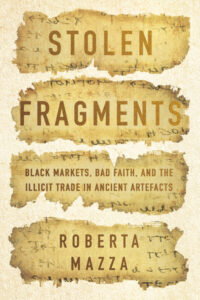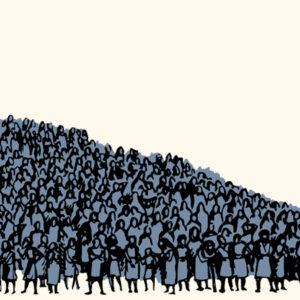
How Evangelical Christians Seek to Influence American Politics Through... Bible Museums?
Roberta Mazza on the Ethics of Imposing an Agenda on Dubiously Acquired Ancient Artifacts
When I first heard of the Green family—the very publicly Evangelical owners of Hobby Lobby—and their collection, I didn’t know much about who they were. My colleagues in the United States, however, were already discussing the project with preoccupation. The Greens decided to invest money and time in collecting objects related to the Bible and its history in 2009.
They appeared on the manuscript collecting scene as outsiders, who however seemed to have very clear ideas about what to do with their acquisitions: they wanted to open a public museum to teach visitors what the Bible is, its history and importance to contemporary Americans, first and foremost. It was the politics behind the museum that worried many of my American colleagues in religious studies: the family’s deep evangelical faith would guide the kind of Bible the museum was going to broadcast, but the Bible has a far more interesting and multifaceted story to tell.
Besides being a masterpiece of world literature, the Christian Bible, which is divided into Old and New Testaments, is holy to believers belonging to different churches and creeds. Today we read these writings in all possible modern languages, but the different books that over time have become canonical (i.e., part of the Bible as established by church authorities) were originally written in ancient languages, primarily Greek.
The first Christians were Jews that followed the teachings of Jesus of Nazareth, a charismatic preacher who was executed by the Romans sometime around 30 CE. After his death, the deeds and teachings of Jesus were transmitted orally and then collected in myriads of writings. Only later were some of these thought more reliable than others, considered holy, and recognized as part of the canonical Christian scriptures under the name of the New Testament.
A major challenge for any museum of the Bible is to present and problematize the formation of this book, or more precisely this collection of books.
This selection process, which formed both the Old and New Testaments, was long and controversial. The outcome was that the books accepted as canonical, and their translations, vary from one Christian group to another. A major challenge for any museum of the Bible is to present and problematize the formation of this book, or more precisely this collection of books, being fair to the many kinds of Christianities coexisting in history and still active today.
Another delicate issue in the history of the Christian Bible (or more precisely Bibles) is its intimate connection with the Jewish scriptures. Because Jesus and his first followers were Jews, they followed the Torah and read that and other Jewish sacred scriptures. These were later again selected and transformed by Christians into their Old Testament. But to transform others’ holy scriptures into your own is not a neutral action. From that beginning, the relationship between Christians and their Jewish roots has gone through periods of appropriation, hostility, and violence, which again should be acknowledged in any museum of the Bible.
Would the Greens and their collaborators be able to convey the many layers and histories of the book in question, considering their affiliation with one specific stream of modern Christianity? This issue worried many academics in biblical disciplines, and some started monitoring how the project of the Green collection and the future museum were unfolding.
The Greens had never made a mystery of their faith and commitment to the Christian Evangelical cause. They brought their religious beliefs into running their successful business—in public speeches, interviews, and publications, the head of the family, David Green, often explained that God and faith were indeed the ultimate reason for their success. In keeping with their owners’ ethos, Hobby Lobby stores are closed on Sundays to give employees and customers time to worship and dedicate to family. In 2014, David Green and his wife Barbara won a Supreme Court case against President Obama’s health care reforms, obtaining the right not to cover contraception prescriptions for their employees.
The year before, the Greens proposed that a school district in Oklahoma City adopt a four-year high school curriculum, paid for by Hobby Lobby and designed by evangelical Christian academics. The proposal raised concerns. By law, the teaching of the Bible in public schools cannot be mandated but is allowed. A Supreme Court decision of 1963 established that the teaching of the Bible in public schools must be scientific, secular, and separate from any particular church or Christian sect’s belief. The Greens, instead, have a very specific and public Christian Evangelical affiliation.
Many thought that the curriculum they were paying for and supporting would be informed by the family’s beliefs rather than following academic methods; it would be a way to proselytize rather than educate. Amid preoccupations about overlap between the program and Hobby Lobby, and an intervention from the Oklahoma County prosecutor’s office, the proposal was at last abandoned.
The Bible artefacts collection and the museum were yet another expression of the family’s cultural and ultimately political project to influence the American public arena, making it more evangelical Christian. The collection and future museum were presented as neutral, but there were good reasons to think that the overarching narrative would reflect the Greens’ views and become the museum of the American Christian Evangelical Bible.
*
As Scott Carroll recalls it, the idea to open a new museum dedicated to the Bible originated not with Steve Green or his family but with Donald Jonathan “Johnny” Shipman. I specify a new museum because in the United States there were already many—although the Green’s was meant to become one of a kind. Shipman, who died of natural causes in 2013, was a Texan businessman with loud manners and tacky outfits whose interests extended from oil to fine jewelry, finance, and Christian movie production. He was also a fervent Baptist who had been very active as a preacher in his youth. He frequented the same evangelical circles as the Green family, and he helped finance a film produced by Mart Green, the eldest son of David, who is in the Christian movie industry among other things.
Shipman understood that the Greens could become major investors in his new venture: the opening of a national museum of the Bible in Dallas, Texas. But to add academic credentials and expertise to the project, he needed someone with a solid background in biblical studies as well as experience with rare books and manuscript collecting: and so he turned to a well-known figure in his circles, Scott Carroll.
Carroll is an energetic man, still to this day touring evangelical churches and schools nationally and internationally to preach the Bible and the evangelical Christian creed. He is a gifted communicator and teacher, who often uses archaeological evidence—objects and manuscripts—to support his main arguments, that the stories told in the Bible are true and that an uninterrupted chain of scribes copied the book, as given by God, throughout antiquity and the Middle Ages. He not only shows PowerPoint slides of sites and objects, as anyone would do, but brings papyrus fragments, cuneiform tablets, Jewish Torah scrolls, and other rarities with him so that his audiences can touch and handle the actual evidence. Sometimes the items are authentic, but he also uses high-quality replicas.
To disseminate Carroll’s teachings, evangelical churches and groups have often filmed his events and uploaded them online. I soon became a collector of these videos, and still file them in my archive, because despite all the troubles he has had with the Green collection, Carroll seems unstoppable: his core business, a Michigan-based charity called Manuscript Research Group, is still active in manifold activities, ranging from education to the production of ancient manuscript replicas. The origin of the authentic biblical and nonbiblical manuscripts and artefacts that Carroll uses and sometimes brokers remains unknown. And I am astonished that nobody has intervened to check on his activities yet.
Carroll holds a PhD in ancient studies from Miami University, in Oxford, Ohio. He defines his training as multidisciplinary, encompassing ancient history, religion, archaeology, classics, and Egyptology, and claims to know thirteen languages. Surely, Carroll developed an interest in the history of Egyptian Christianity and its liturgical language, Coptic, while writing his dissertation in that area, but the way he handles papyri and speaks about their contents makes me wonder about his abilities. Papyri are normally kept between special glass panes to protect their surfaces from damage, but this does not mean that, once glazed, these rare artefacts can be carried around as if they were everyday objects.
But Carroll goes to public gatherings carrying papyri in his pockets and holding glass frames hazardously high to show them to his audiences—papyrologists use trays and would in any case normally avoid bringing papyri outside climate-controlled spaces. In his talks, Carroll uses bizarre terminology. In one video filmed for the Green collection in 2012, he refers to papyrus assemblages, probably fabricated by modern dealers, as “thingamajigs.” Despite his claims to be a textual expert, he has published very little to nothing in peer-reviewed journals, which is what specialists normally do, and not a single article with a fresh edition of an ancient manuscript.
At Miami University, Carroll became friends with Jerry Pattengale, a fellow student who shared interests in the formation of the first Christian communities. The two, however, have quite different temperaments. In his youth, Carroll was an athlete, all action, while Pattengale, a more poised character, had the manners and attitudes required to work at a university and other organizations. To some extent they complement each other.
After graduation, Carroll started teaching at Christian colleges and published a couple of articles, while Pattengale’s career took him to Indiana Wesleyan University, where he developed an interest in education and pedagogy and climbed the ladder of faculty administration. But over the years, two projects involving big money and biblical artefacts brought the two friends back together: the Van Kampen and then the Green collections. Besides sharing the same evangelical circles, it was their experience with the Van Kampen collection in the 1990s that opened the doors to the Greens’ collection.
Robert Van Kampen (1938–1999) was a businessman and Bible collector from Chicago who, like the Greens, made the evangelical faith central to his life and career. He also created Van Kampen Merritt, an investment fund that made his fortune in the late 1970s and allowed him to spend the rest of his life collecting rare Bibles and manuscripts as well as writing books on the evangelical theology of the Revelation. Van Kampen believed in pre-wrath rapture eschatology, according to which at his second coming, Christ would take evangelical Christians to heaven, leaving the rest of us to deal with the apocalypse and God’s wrath. Van Kampen had explained his views in various publications, most notably a novel where Hitler (aka Satan) comes back from the dead and restores his Reich. But this time the Reich brings about the end-times.
The Bible artefacts collection and the museum were yet another expression of the family’s cultural and ultimately political project to influence the American public arena.
In the 1990s, the Van Kampen family moved to Grand Haven, Michigan, where they built an impressive mansion that also hosted the Scriptorium, a museum-library for their collection and since 1994 an academic research initiative, too. Among the specialists enrolled by the Scriptorium were Scott Carroll and Jerry Pattengale. Van Kampen’s cultural activities extended outside the United States also. The millionaire bought Hampton Court Castle in Herefordshire, England, where conferences and seminars took place. In 1995 and 1996 he sponsored an excavation in Egypt, at Wadi el-Natrun, the desert area between Cairo and Alexandria where Christian Coptic monks live, still following the paths of communities established in late antiquity by their founders.
The Scriptorium’s archaeological mission aimed at uncovering the ancient monastic buildings that predate the medieval and still active monastery of St. Bishoi at Wadi el-Natrun. This monastery is famous for its book and manuscript collections, which are extensive despite British manuscript hunter Robert Curzon (1810–1873), the fourteenth Baron Zouche and an avid collector, having ransacked them in the mid-nineteenth century. Curzon went so far as to make some monks drunk so he could get into the book deposits and buy some rarities at a cheap price. Most of Curzon’s prey are now stored in the British Library.
Perhaps Carroll was trying to be a new Curzon to benefit this new breed of evangelical Christian collectors—I wondered while watching one of the oldest videos in my collection, the promo of an educational project called Odyssey in Egypt, shot during the Van Kampen excavations. The project was ingenious and innovative for the mid-1990s. School pupils in Michigan were able to follow the work of the archaeologists through video reports and a website. They could also send questions via email to members of the team.
But excavations were not the only activity filmed at Wadi el-Natrun, and that is why I started wondering about Carroll’s activities there. Like Curzon, Carroll was able to get inside the monastery’s cells. A video frame from the promo of Odyssey in Egypt stuck in my mind. It shows one of the monks sitting with an ancient book open on his lap, to pray and meditate.
From late antiquity onward monastic communities spent part of their time copying and translating early Christian texts from Greek and other languages to Egyptian Coptic—a late development of the Egyptian language, with different dialects, written in an alphabet based on the Greek plus a set of new letters. This language and its alphabet, and the books translated by the monks, are still used for the Coptic liturgy in churches. But apart from Odyssey in Egypt, very little came out of the two excavation seasons in Egypt, as no archaeological report was ever published. Then Robert Van Kampen died in 1999 and the Scriptorium came to an end, since the heirs decided to move their artefacts to the Holy Land Experience, a biblical theme park in Orlando, Florida.
When I started looking at the history and nature of the Van Kampen collection, to understand why in evangelical Christian circles papyrus and manuscript collecting had become “a thing,” I was intrigued as there were overlaps with the Green collection’s modus operandi. In both cases, the collectors were devout evangelical Christians highly invested in the history of the Bible. In both cases, they wanted their collections to be studied by scholars. In both cases, the provenance of the artefacts they had acquired was far from clear. If they ever bothered checking the collection history of the manuscripts they purchased, this was never disclosed in public catalogs and databases and never explained when people, like myself, asked.
To be clear: there is no extant, accessible catalog attesting the range, size, and provenance of the ancient manuscripts collected by Robert Van Kampen, only vague descriptions of the collection in superseded websites accessible only through the Internet Archive. It is also uncertain where the collection is now stored, because the Holy Land Experience has recently shut down.
__________________________________

Excerpted from Stolen Fragments: Black Markets, Bad Faith, and the Illicit Trade in Ancient Artefacts by Roberta Mazza, published by Redwood Press, an imprint of Stanford University Press, ©2024 by Roberta Mazza. All Rights Reserved.
Roberta Mazza
Roberta Mazza is Associate Professor of Papyrology at the University of Bologna. She previously held positions at the University of Manchester, where she was honorary curator of the Manchester Museum, and at the University of California, Berkeley.












